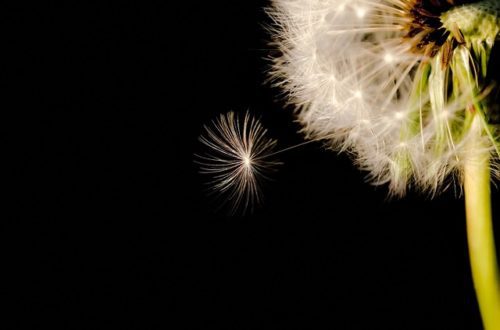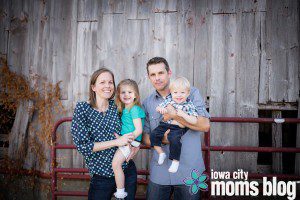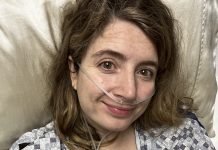After two years of infertility treatments and two healthy IVF babies, my husband and I were confident that our family was complete. However, we had three embryos left that we were not going to use. We chose embryo adoption, donating our three remaining frozen embryos to an infertile couple.
We wanted to know if a baby resulted from our donation, so we chose the recipients ourselves. Not every couple with extra embryos has a desire to know how the story ends; some are more comfortable not knowing. We connected with a couple from Minnesota, Lauren and Jesse.
Even though we chose to do a known donation, little did we know that anonymous donation would later become part of this story, too.
Lauren and Jesse transferred the first of the embryos in October 2015, at UIHC, and within days Lauren saw something she’d never seen before: two pink lines.
She was pregnant.
On November 18, something terrible happened. During their second ultrasound, they discovered the baby had no heartbeat. Lauren opted for a D&C, and her doctor in Minnesota suggested genetic testing on the fetus. The baby had Trisomy 18, a genetic abnormality that’s a common cause of first-trimester miscarriage. And the baby had been a girl.
I was overwhelmed with guilt. I had given her a broken embryo, one incompatible with life. There was no way I could have known (we didn’t do genetic testing on our embryos), but it didn’t change how bad I felt. Lauren and Jesse were paying for everything out of pocket, and she’d just gone through the gut-wrenching experience of a miscarriage . . . all for nothing. I blamed myself.

Lauren is an optimist, thankfully, and by February, she was ready to try again with the second embryo. A few days later, a pregnancy test showed two pink lines. This time the joy was short-lived. The lines started to fade within days, and soon the second line had faded to nothing. It’s called a chemical pregnancy, and it’s impossible to know why the pregnancy began but didn’t “stick.”
In June 2016, they transferred the third and final embryo. Like before, her pregnancy test was positive. Like before, bad news followed the good: another chemical pregnancy.
We were all upset.
Lauren and Jesse had poured their time, emotion, and thousands of dollars into this possibility for a child, and came out empty-handed and emotionally beaten down.
One miscarriage; two “now you see it, now you don’t” chemical pregnancies. This. Sucked.
For me, the guilt was overwhelming. I’d failed Lauren and Jesse. I’d failed myself, in my mission to give someone a baby.
Worse yet, I was relieved. Because our embryos hadn’t resulted in a baby, I wouldn’t have to spend the rest of my life watching someone else raise a child that was genetically mine. I recognized it was a possibility from the get-go, but I also knew it would be difficult if that came to pass.
Lauren and I promised we’d stay friends, but it was rough. Every time I heard from her, I was reminded of the fact that Lauren and Jesse still had no child of their own.
There was one bright side: because Lauren and Jesse had seen a heartbeat on ultrasound, their insurance infertility benefits had reset. They could have six more intrauterine inseminations (IUIs) covered by insurance. Before pursuing embryo adoption, they had exhausted six IUIs and had never seen a positive pregnancy test. Jesse’s sperm quality was poor and the doctors gave them a 3% chance of conceiving. But now, after a year of acupuncture and supplements, a semen analysis showed that Jesse’s sperm quality had improved dramatically. They were willing to try; what could it hurt?
Four months later, after IUI number two, something amazing happened: Lauren was pregnant, and this time it was their own genetic child. They were over the moon, and so was I. Our failed donation, even though it hadn’t given them a baby, had opened a door that brought them closer to being parents.
These two deserving people, who’d been through almost six years of infertility treatments—negative pregnancy tests, disappointments, loss, and unbelievable grief—had taken on more than their share of sadness.
Surely the universe was done beating up on them. This was their happy ending. We were sure of it.
We were wrong.
On November 18, exactly one year after her first miscarriage, Lauren miscarried again.
I tried to be comforting, but mostly gave Lauren space to grieve. Autumn was ending, and the bitter cold of winter was arriving. The dark and cold hung heavy.
Then, in December, Lauren got a phone call. A nurse from UIHC’s infertility clinic let them know that their names had come to the top of the list for anonymously donated embryos. Were they still interested? Lauren had completely forgotten, but after the third failed transfer, UIHC had asked Lauren and Jesse if they wanted to be on the list for anonymously donated embryos. They shrugged and said sure. At that point, they couldn’t foresee a reality where they would use more donor embryos. Three strikes, time to try something else—hopefully something that would actually work.
Because they’d already gone through the steps of receiving donated embryos, many of the requirements and associated costs were waived. This time, everything would be much more affordable.
Surely the universe was done beating up on them. This was their happy ending. We were sure of it.
Lauren and Jesse scheduled a trip to review donor profiles and choose a set of embryos. They faced a difficult decision; no one’s genetic history is perfect. Should they choose three good-quality embryos with a family history of Alzheimer’s? Or the batch with several grandparents having died of cancer? Of course, people with a family history of cancer and Alzheimer’s have babies all the time; nobody’s genes are perfect. Lauren and Jesse chose a set of embryos, and returned in February for the first transfer.
Nine days later: a positive pregnancy test. Given Lauren’s history with miscarriage, however, their optimism was lined with caution. The days crept by, eventually turning into weeks. At six weeks, the first ultrasound showed the baby looking great, with on-track growth and a strong heartbeat. At eight weeks, a second ultrasound: Baby was perfect. Nine weeks turned into ten, then eleven.
Near the end of her 12th week, Lauren texted me. She was shopping with her mom, and while at Pier One, her mother had patted Lauren’s stomach and told a clerk, “My grandbaby’s in there.”
In late April, Lauren and Jesse got word from their doctor. The genetic test results had come back: she was carrying a healthy baby girl.
Our three donated embryos, the $20,000 Lauren and Jesse spent to transfer them, and the devastating loss of all three… all that money, time, and emotion that I assumed was wasted, wasn’t a waste at all.
It was all part of the plan to get Lauren and Jesse to this baby.
Their baby.
My friends Lauren and Jesse are going to be parents in November. My three little embryos, even though they weren’t meant to be Lauren and Jesse’s baby, had a tiny part in their story.
That gives our embryo donation story a decidedly happy ending.
Special thanks to our guest blogger, Lydia Fine!
Lydia lives in North Liberty with her husband and two children. Considering embryo donation? Read more about how it all works on Lydia’s blog, PeanutMom.com.










